 By 9th February 1942 work was well-advanced on adapting USS Lafayette (ex-Normandie) into a troopship, capable of carrying over 14,000 troops. There were over 3,000 workers aboard, including civilian contractors, Coast Guards, Navy personnel and others. Concerns were raised about safety on board, and it had been decided to remove the four large lighting fixtures and benches in the Grand Salon. The glass segments were dismantled and taken ashore, and the seating removed, leaving the basic metal frames. The carpet in the Grand Salon had been rolled up, ready to be replaced with linoleum. The fireproof partition between the Grand Salon and the Smoking Room had been dismantled. Also in the Grand Salon were bundles of lifejackets, filled with kapok and wrapped in hessian.
By 9th February 1942 work was well-advanced on adapting USS Lafayette (ex-Normandie) into a troopship, capable of carrying over 14,000 troops. There were over 3,000 workers aboard, including civilian contractors, Coast Guards, Navy personnel and others. Concerns were raised about safety on board, and it had been decided to remove the four large lighting fixtures and benches in the Grand Salon. The glass segments were dismantled and taken ashore, and the seating removed, leaving the basic metal frames. The carpet in the Grand Salon had been rolled up, ready to be replaced with linoleum. The fireproof partition between the Grand Salon and the Smoking Room had been dismantled. Also in the Grand Salon were bundles of lifejackets, filled with kapok and wrapped in hessian.
 The lighting stanchions were 15 feet high, on a 20 inch base that contained ventilation ducts. It was decided to leave the bases, to create large tables, but to cut off the stanchions. A welding/cutting crew were assigned to the job. The first two stanchions were removed before lunch. After lunch the two men assigned to hold asbestos sheets to contain any sparks had been assigned to other work, and the replacements hadn’t arrived. The team removed the third stanchion and moved on to the fourth one. The cutting crew had to toss bundles of lifejackets to one side to create space. Apart from a couple of buckets of water, there were no hoses laid down, and no other precautions taken. As Clement Derrick shut through the leg of the stanchion, sparks from the oxy-acetylene torch caught on some of the life-jackets, which quickly caught fire.
The lighting stanchions were 15 feet high, on a 20 inch base that contained ventilation ducts. It was decided to leave the bases, to create large tables, but to cut off the stanchions. A welding/cutting crew were assigned to the job. The first two stanchions were removed before lunch. After lunch the two men assigned to hold asbestos sheets to contain any sparks had been assigned to other work, and the replacements hadn’t arrived. The team removed the third stanchion and moved on to the fourth one. The cutting crew had to toss bundles of lifejackets to one side to create space. Apart from a couple of buckets of water, there were no hoses laid down, and no other precautions taken. As Clement Derrick shut through the leg of the stanchion, sparks from the oxy-acetylene torch caught on some of the life-jackets, which quickly caught fire.
The foreman ran for the hose on the Promenade Deck but there was no pressure in the main; the instructions were still in French which no-one could understand. Some of the nearby workers tried to toss the burning bundles of lifejackets outside, but some fell on the carpeting, which in turn started it burn. The central fire station had been dismantled and the replacement had not yet been set up. The alarm system to the local city fire brigade had been disconnected when the US Navy took over the vessel. There were a few fire extinguishers in nearby lockers, but no-one knew they were there, and by this time would have been inadequate anyway.
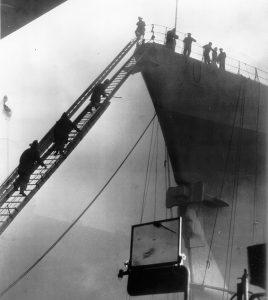 The fire doors to the Main Salon, which should have been shut, were open and the fire started to spread. Other fire doors were blocked with scaffolding, tools and debris and couldn’t be shut. Some 15 minutes after the fire started the first fire engines arrived, and soon after the first fire boat. The firemen struggled to get on board as all the workers were fighting to get off. Some workers had to be rescued from ladders propped up from the quayside to the bow!
The fire doors to the Main Salon, which should have been shut, were open and the fire started to spread. Other fire doors were blocked with scaffolding, tools and debris and couldn’t be shut. Some 15 minutes after the fire started the first fire engines arrived, and soon after the first fire boat. The firemen struggled to get on board as all the workers were fighting to get off. Some workers had to be rescued from ladders propped up from the quayside to the bow!
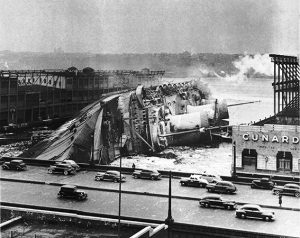 Several hours after, with too much water aboard and no way of draining it fast enough, Lafayette slowly started to list, and sadly, some 12 hours after the fire had started, she rolled over and capsized. Although many ideas were suggested in the coming months to raise her and rebuild her, it was not economical or practical, and by now the war was entering a new phase. Finally the decision was taken to dismantle most of her superstructure, the raise the rest and scrap the remains.
Several hours after, with too much water aboard and no way of draining it fast enough, Lafayette slowly started to list, and sadly, some 12 hours after the fire had started, she rolled over and capsized. Although many ideas were suggested in the coming months to raise her and rebuild her, it was not economical or practical, and by now the war was entering a new phase. Finally the decision was taken to dismantle most of her superstructure, the raise the rest and scrap the remains.

 At 10.00am on 8th February 1950 a 75-ton crane on the south side of Slipway No. 10 at Newport News swung into action. The first sections of the keel for what was to become the last liner to win the Blue Riband was laid. This was the start of SS United States. The design, by W.F. Gibbs, incorporated special strengthening around the bow to resist any heavy pounding when driving through the north Atlantic, and the stern incorporated additional strengthening to resist the torque from the massive engines and the propellers.
At 10.00am on 8th February 1950 a 75-ton crane on the south side of Slipway No. 10 at Newport News swung into action. The first sections of the keel for what was to become the last liner to win the Blue Riband was laid. This was the start of SS United States. The design, by W.F. Gibbs, incorporated special strengthening around the bow to resist any heavy pounding when driving through the north Atlantic, and the stern incorporated additional strengthening to resist the torque from the massive engines and the propellers. Extensive use was to be made of aluminium in the construction of SS United States – superstructure, panelling, furniture, even the deck chairs. All the aluminium used had a protective coating of zinc chromate to resist the effects of salt water. Although steel rivets were used in much of the steel hull construction, as well as welding, special aluminium rivets were used elsewhere. Gibbs had a total phobia about fire aboard ships, and he ensured there was virtually no wood aboard.
Extensive use was to be made of aluminium in the construction of SS United States – superstructure, panelling, furniture, even the deck chairs. All the aluminium used had a protective coating of zinc chromate to resist the effects of salt water. Although steel rivets were used in much of the steel hull construction, as well as welding, special aluminium rivets were used elsewhere. Gibbs had a total phobia about fire aboard ships, and he ensured there was virtually no wood aboard. All his efforts paid off when the liner gained the speed record on her maiden voyage. She made the crossing in 3 days 10 hours 40 minutes, taking over 10 hours off Queen Mary‘s record, held since 1938. She was to be the last trans-Atlantic passenger liner built for the route to gain the record and the Hales Trophy.
All his efforts paid off when the liner gained the speed record on her maiden voyage. She made the crossing in 3 days 10 hours 40 minutes, taking over 10 hours off Queen Mary‘s record, held since 1938. She was to be the last trans-Atlantic passenger liner built for the route to gain the record and the Hales Trophy. On 5th February 1938 Normandie set sail from New York, heading for Rio de Janeiro and the world-famous Carnival. This spectacular 22-day cruise was organised by a Boston travel agency, Raymond-Whitcomb. For this cruise, Normandie was operated as one-class, with nearly 1,000 passengers aboard. In a precursor to today’s cruise liners, the agency even hired a cruise director with an assistant, a social director and a large entertainments staff to keep everyone amused. A variety of professional entertainers were brought along.
On 5th February 1938 Normandie set sail from New York, heading for Rio de Janeiro and the world-famous Carnival. This spectacular 22-day cruise was organised by a Boston travel agency, Raymond-Whitcomb. For this cruise, Normandie was operated as one-class, with nearly 1,000 passengers aboard. In a precursor to today’s cruise liners, the agency even hired a cruise director with an assistant, a social director and a large entertainments staff to keep everyone amused. A variety of professional entertainers were brought along. With stops at Nassau and Trinidad on the way south, Normandie arrived at Rio in the early hours of 16th February, at Guanabara Bay, and soon after passengers began pouring onto the tenders to go ashore. However, in all the advance planning, no-one had thought to arrange for tickets and invitations to the various balls held during the Carnival. All the passengers could do was enjoy the street parties! Leaving Rio on 18th February, stopping at Martinique to refuel, Normandie was back at New York on 27th February.
With stops at Nassau and Trinidad on the way south, Normandie arrived at Rio in the early hours of 16th February, at Guanabara Bay, and soon after passengers began pouring onto the tenders to go ashore. However, in all the advance planning, no-one had thought to arrange for tickets and invitations to the various balls held during the Carnival. All the passengers could do was enjoy the street parties! Leaving Rio on 18th February, stopping at Martinique to refuel, Normandie was back at New York on 27th February. Immediately prior to the Great War, Cunard introduced a class of three liners: Andania, Alaunia and Aurania, for the Canadian service. These were twin-funnelled liners; the first two were built by Scott’s of Greenock and the third by Swan, Hunter. They were twin-screw vessels of 13,500grt, 540 feet long, and could carry over 500 passengers in Second Class and over 1,600 in Third Class. None were to survive the war. The grey photograph is of Aurania, the other is of the sister, Andania.
Immediately prior to the Great War, Cunard introduced a class of three liners: Andania, Alaunia and Aurania, for the Canadian service. These were twin-funnelled liners; the first two were built by Scott’s of Greenock and the third by Swan, Hunter. They were twin-screw vessels of 13,500grt, 540 feet long, and could carry over 500 passengers in Second Class and over 1,600 in Third Class. None were to survive the war. The grey photograph is of Aurania, the other is of the sister, Andania.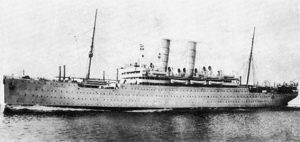 Aurania was launched on 16th July 1916, but was completed as a troopship. She made her maiden voyage on 28th March 1917, from Newcastle to New York. After only seven trips, she left Liverpool on 3rd February, travelling in ballast for New York, to collect troops and munitions. On 4th February 1918 she was torpedoed by the German submarine UB-67, some 15 nautical miles north of the Irish coast. Badly damaged, she was taken in tow by a trawler, but ran aground on the rocks off Tobermory and was declared a total loss. Eight died in the tragedy.
Aurania was launched on 16th July 1916, but was completed as a troopship. She made her maiden voyage on 28th March 1917, from Newcastle to New York. After only seven trips, she left Liverpool on 3rd February, travelling in ballast for New York, to collect troops and munitions. On 4th February 1918 she was torpedoed by the German submarine UB-67, some 15 nautical miles north of the Irish coast. Badly damaged, she was taken in tow by a trawler, but ran aground on the rocks off Tobermory and was declared a total loss. Eight died in the tragedy.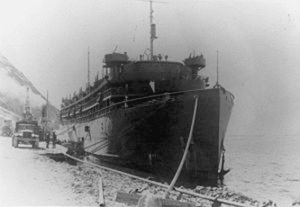 SS Dorchester was a troopship allocated to the US Army during World War II. She was one of three ships in a class built by Newport News Shipbuilding: the keel was laid on 10th September 1925 and she was launched on 20th March 1926. Handed over to Merchants and Miners Transportation on 17th July 1926, she could carry 302 passengers in First Class and 3,300 tons of cargo on a coastal service between Miami and Boston.
SS Dorchester was a troopship allocated to the US Army during World War II. She was one of three ships in a class built by Newport News Shipbuilding: the keel was laid on 10th September 1925 and she was launched on 20th March 1926. Handed over to Merchants and Miners Transportation on 17th July 1926, she could carry 302 passengers in First Class and 3,300 tons of cargo on a coastal service between Miami and Boston.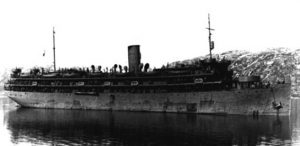 She had been taken over by the US War Shipping Administration on 24th January 1942 and converted to a troopship: additional lifeboats and life rafts were fitted along with four 20mm guns, a 3-in 50-calibre gun forward and a 4-in 50-calibre gun aft. After conversion she could carry over 900 troops. She entered service in February 1942, still with her original captain and crew, plus a contingent of US Navy personnel to handle the guns and communications. However, she was not owned or chartered by the Army so was not officially classified as USAT. She sailed from New York on 23rd January 1943 heading for Greenland, in a convoy of three ships, SG-19, with an escort of three US Coast Guard cutters. In the early hours of 3rd February 1943, Dorchester was torpedoed off Newfoundland by the German submarine U-223, and she sank in around 20 minutes. The explosion was severe, with an immediate loss of all power and communications. One of the cutters, Escanaba, moved in and managed to save 133, and another cutter, Comanche, saved 97 of the 904 personnel aboard. The water was freezing cold and the air temperature just 34°F: many died from hypothermia. The sinking of Dorchester was the worst single loss of American personnel in any American convoy during the war and the third worst loss of life at sea suffered by the US.
She had been taken over by the US War Shipping Administration on 24th January 1942 and converted to a troopship: additional lifeboats and life rafts were fitted along with four 20mm guns, a 3-in 50-calibre gun forward and a 4-in 50-calibre gun aft. After conversion she could carry over 900 troops. She entered service in February 1942, still with her original captain and crew, plus a contingent of US Navy personnel to handle the guns and communications. However, she was not owned or chartered by the Army so was not officially classified as USAT. She sailed from New York on 23rd January 1943 heading for Greenland, in a convoy of three ships, SG-19, with an escort of three US Coast Guard cutters. In the early hours of 3rd February 1943, Dorchester was torpedoed off Newfoundland by the German submarine U-223, and she sank in around 20 minutes. The explosion was severe, with an immediate loss of all power and communications. One of the cutters, Escanaba, moved in and managed to save 133, and another cutter, Comanche, saved 97 of the 904 personnel aboard. The water was freezing cold and the air temperature just 34°F: many died from hypothermia. The sinking of Dorchester was the worst single loss of American personnel in any American convoy during the war and the third worst loss of life at sea suffered by the US. best remembered for the four Army chaplains who gave up their lifejackets and their lives to help others survive, seeing many into the lifeboats. These were a Methodist minister, George Fox, a Reformed Church minister, Clark Poling, a Catholic priest, John Washington, and a Rabbi, Alexander Goode. When there were no more boats or lifejackets, they were seen to link arms, say prayers and sing hymns together. On 19th December 1944 all four chaplains were posthumously awarded the Purple Heart and the Distinguished Service Cross. Congress wanted to grant the Medal of Honor but the condition for that award required heroism when under fire. In honour of their sacrifice the US Congress later declared 3rd February to be established as “Four Chaplains Day”, and in 1960 a special medal for heroism, the Chaplain’s Medal, was created.
best remembered for the four Army chaplains who gave up their lifejackets and their lives to help others survive, seeing many into the lifeboats. These were a Methodist minister, George Fox, a Reformed Church minister, Clark Poling, a Catholic priest, John Washington, and a Rabbi, Alexander Goode. When there were no more boats or lifejackets, they were seen to link arms, say prayers and sing hymns together. On 19th December 1944 all four chaplains were posthumously awarded the Purple Heart and the Distinguished Service Cross. Congress wanted to grant the Medal of Honor but the condition for that award required heroism when under fire. In honour of their sacrifice the US Congress later declared 3rd February to be established as “Four Chaplains Day”, and in 1960 a special medal for heroism, the Chaplain’s Medal, was created.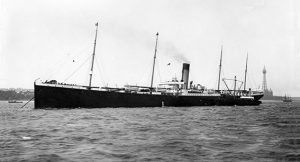 Launched at Harland & Wolff, Belfast on 16th November 1898 as Yard Number 322, Afric was handed over to White Star on 2nd February 1899. She was the first of three sisters: Afric, Medic and Persic. These vessels were 550 feet long, 11,948grt, twin propeller vessels. As well as carrying 320 Cabin Class passengers, she could carry 15,000 tons of general cargo and had 240,000 cubic feet of refrigerated space for up to 100,000 carcasses of Australian meat.
Launched at Harland & Wolff, Belfast on 16th November 1898 as Yard Number 322, Afric was handed over to White Star on 2nd February 1899. She was the first of three sisters: Afric, Medic and Persic. These vessels were 550 feet long, 11,948grt, twin propeller vessels. As well as carrying 320 Cabin Class passengers, she could carry 15,000 tons of general cargo and had 240,000 cubic feet of refrigerated space for up to 100,000 carcasses of Australian meat. With the outbreak of the Great War, Afric was one of the first liners to be requisitioned, as HM Transport A19, and in October was in the first convoy to bring Australian and New Zealand troops to the war in Europe. In April 1915 Afric was converted at Sydney to carry over 500 troops and 500 horses. On 12th February 1917, en route from Liverpool to Plymouth then Sydney, she was torpedoed and sunk by UC66 off the Eddystone Lighthouse. Five were killed in the explosion and a further 17 drowned.
With the outbreak of the Great War, Afric was one of the first liners to be requisitioned, as HM Transport A19, and in October was in the first convoy to bring Australian and New Zealand troops to the war in Europe. In April 1915 Afric was converted at Sydney to carry over 500 troops and 500 horses. On 12th February 1917, en route from Liverpool to Plymouth then Sydney, she was torpedoed and sunk by UC66 off the Eddystone Lighthouse. Five were killed in the explosion and a further 17 drowned. Republic left Liverpool for New York on her maiden voyage on 1st February 1872. Built at Harland & Wolff, Belfast, she had accommodation for 166 in First Class and 1,000 in Third Class. Launched on 4th July 1871 she was fitted for sail as well as an engine from Forrester’s. On her first trip, Captain Murray was not impressed by the quality of construction, and on his return sent in a damning report to the company. There is no apparent record of the company’s – or Belfast’s – reaction! In October 1872 she was transferred to the new steamer service to South America.
Republic left Liverpool for New York on her maiden voyage on 1st February 1872. Built at Harland & Wolff, Belfast, she had accommodation for 166 in First Class and 1,000 in Third Class. Launched on 4th July 1871 she was fitted for sail as well as an engine from Forrester’s. On her first trip, Captain Murray was not impressed by the quality of construction, and on his return sent in a damning report to the company. There is no apparent record of the company’s – or Belfast’s – reaction! In October 1872 she was transferred to the new steamer service to South America. With new ships joining the fleet, in 1888 Republic was put up for sale. On her final voyage for White Star she ran aground off Sandy Hook but was refloated, then once she had docked part of the boiler exploded. On her return to the UK she was laid up at Birkenhead, and in June 1889 sold to Holland America as Maasdam. She was refitted and given new engines.
With new ships joining the fleet, in 1888 Republic was put up for sale. On her final voyage for White Star she ran aground off Sandy Hook but was refloated, then once she had docked part of the boiler exploded. On her return to the UK she was laid up at Birkenhead, and in June 1889 sold to Holland America as Maasdam. She was refitted and given new engines. In August 1902 she was sold to La Veloce of Genoa and renamed Vittoria, running from Genoa to New York on the emigrant service, carrying 1,424 in steerage. Some time later she was renamed Citta di Napoli, for the same owners. She was laid up in 1908 and was scrapped at Genoa in 1910.
In August 1902 she was sold to La Veloce of Genoa and renamed Vittoria, running from Genoa to New York on the emigrant service, carrying 1,424 in steerage. Some time later she was renamed Citta di Napoli, for the same owners. She was laid up in 1908 and was scrapped at Genoa in 1910.